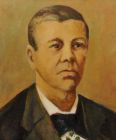|
Страница 2 из 4
In the 16th century there was made an attempt to remove the monastery to a safer place, to "Zasechnaya cherta"1 under the protection of Russian frontier troops. However the icon of the Holy Apostle and Evangelist John the Theologian which was taken by the conventual community to the new place moved back itself and the monks returned to the monastery after it.
Till the middle of the 17th century all the buildings in the monastery were wooden.
After the enactment of the decree issued by Empress Catherine the Great dated 1764 which concerned secularization of church or monastery lands or reserves the monastery of the Holy Apostle and Evangelist John the Theologian as well as many other Russian cloisters began to fall into decay. The period of new spiritual and economic prosperity began for it in the second half of the 19th century.
 In 1860 David Ivanovich Khludov, a hereditary honorary citizen, a merchant belonging to the top guild purchases a county seat not far from the cloister. He became the main benefactor of the monastery. Hieromonk Vitaly (Vinogradov) was appointed Father Superior of the cloister on the 22nd of March 1865. The monastery itself turned into a coenoby. In 1860 David Ivanovich Khludov, a hereditary honorary citizen, a merchant belonging to the top guild purchases a county seat not far from the cloister. He became the main benefactor of the monastery. Hieromonk Vitaly (Vinogradov) was appointed Father Superior of the cloister on the 22nd of March 1865. The monastery itself turned into a coenoby.
Hieromonk Vitaly who further became a hegumen and an archimandrite ruled over the cloister for half a century and died in 1915 being about 100 years old. The number of monks in the conventual community increased in the period of his administration and counted over 100 people.
Many wonderful acts of God were shown through the icon of the Holy Apostle and Evangelist John the Theologian and numerous wonderful recoveries took place at the Holy Spring situated near the monastery, near the ancient monastery caves.
______________________________________
1 "Zasechnaya cherta" is a chain of fortification lines, created by Muscovy to protect it from the rides of the Crimean Tatars who, rapidly moving along the Muravsky Trail, ravaged the southern provinces of Russia during a series of the Russo-Crimean Wars.
|